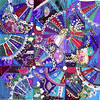Drawn Thread Work
I have always been drawn to Drawn Thread Work (no pun intended). Somewhere, I have a beautiful piece that has come down through the family, but do you think I can find it? No.
It must be the most basic and essential form of fancywork a woman could do - all she needed was some reasonable even-weave white cotton fabric (I think mine are cotton, not linen), and some white thread. I am not totally sure what they used, possibly it was crochet cotton.
Pull out the threads in the necessary places and group the remaining threads, using the white thread. Then add some needle weaving accents - as in the Maltese crosses in the example above. I THINK the spider webs were formed as part of the grouping process.
I am also wondering if it reached its peak in the 1930s Depression - around the time Chicken Scratch was popular. It certainly was a low-cost option that produced stunning results.
So, what I am thinking about now - is does anyone do it any more? I don't think I have seen much in the way of contemporary discussion about it.
There is an entry on it in Wikipedia, but that doesn't really show the sort of work I mean, although there is a good example of hem stitching, which I learned at school. In the 1960s they still taught "proper" needlework in my secondary school. But not a lot I can find on the net.
Think I need to go and have a very serious search for the piece I have. Somewhere.
(Oh, yes. This piece is from the collection at Old Gppstown).








7 Comments:
Hey Linda - Happy New Year to you!
Lovely piece of drawn threadwork. I too am drawn to it. According to my Mum, my paternal grandmother did a lot of this work - though I really don't know where it went - I will have to ask around my siblings.
Mum told me that grandma used ordinary white cotton sewing thread as it was cheaper than the proper embroidery thread and that she used all types of cotton materials even tea towels. She would usually make up her own patterns too.
The same with crochet - she would use sewing thread and just look at a picture of a doiley and be able to crochet it.
By the way, you have been tagged - just 5 random things about yourself and pass on to another 5 ladies.
a lot of times the thread they pulled out was the thread used for the stitch work but not always. It is still done. Some of the filling parts are also called teneriffe lace polka spider web and Nanduti lace are all about the same type of filler stitches. Filler stitches are used where the thread drawn out cross leavening an empty square hole then these are filled in with needle woven lace. You can still find this work done in the Azores Spain and in south American not so much In the USA I don't know about European, Russia, Africa, or Australia.
take care
sunshine
hi Linda some women at the embroiderers guild here in Canberra still do it - and I have worked the odd sample for fun - but it is hard on the eyes
Linda, withdrawn thread work is still very popular in the NSW Embroiderers' Guild. Recently at our 50th Anniversary Exhibition Competition there were some stunning withdrawn thread entries, particularly from Maree Laurie from country NSW. The main thing seems to be to use a similar weight thread to those being withdrawn. There is a Y. group called Needlelace and More where we discuss this type of work as well, as a lot of the filling stitches are common to both techniques. I did a little back in high school, but not a lot now, LOL. Thanks for sharing your photo, lovely work.
Hooroo,
Christine in sunny Sydney Australia
http://missmuffettwo.blogspot.com/
Linda, forgot to add that a lot of people in our Guild are also doing Reticella, a form of lace made by withdrawing threads. Have a look at my friend Jenny's blog, scroll down and see some of her efforts.
http://jennysaustralianneedleart.blogspot.com/
Jenny also does contemporary withdrawn thread work, quite lovely.
Christine
http://missmuffettwo.blogspot.com/
Hi Linda,
Been a while since I dropped in here, and I'm glad I decided to tonight! You have some lovely pieces of stitching here. Drawn threadwork is quite popular at the Embroiderer's Guild of Vic. too. I have never tried it, but I have quite a few items drawnwork and other whitework which were made by one (or both) of my grandmothers. I don't know who did them, but my father gave them to me before he died, saying he wanted them kept in the family.
I really like this piece!! You did a fabulous job!
I saw your link on Pamela Kellogg's blog, so I clicked on it! I hope you don't mind the comments of a stranger! :-/
~Julie~
Post a Comment
<< Home